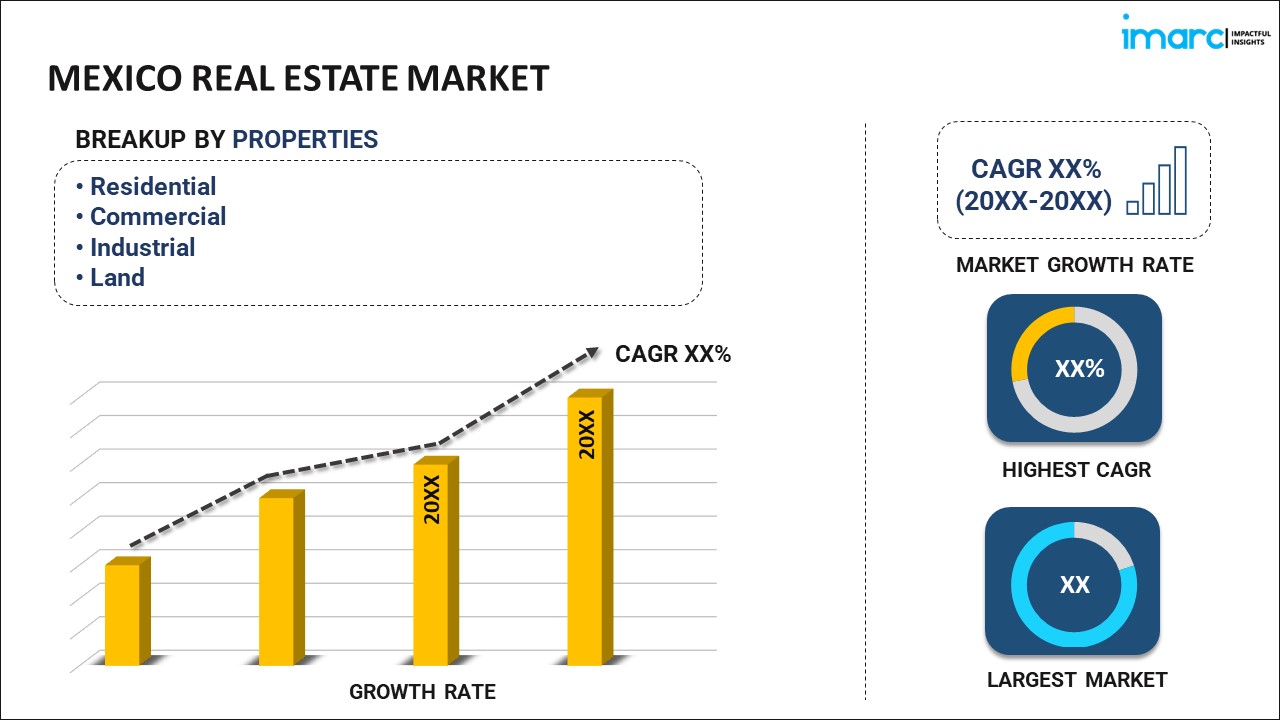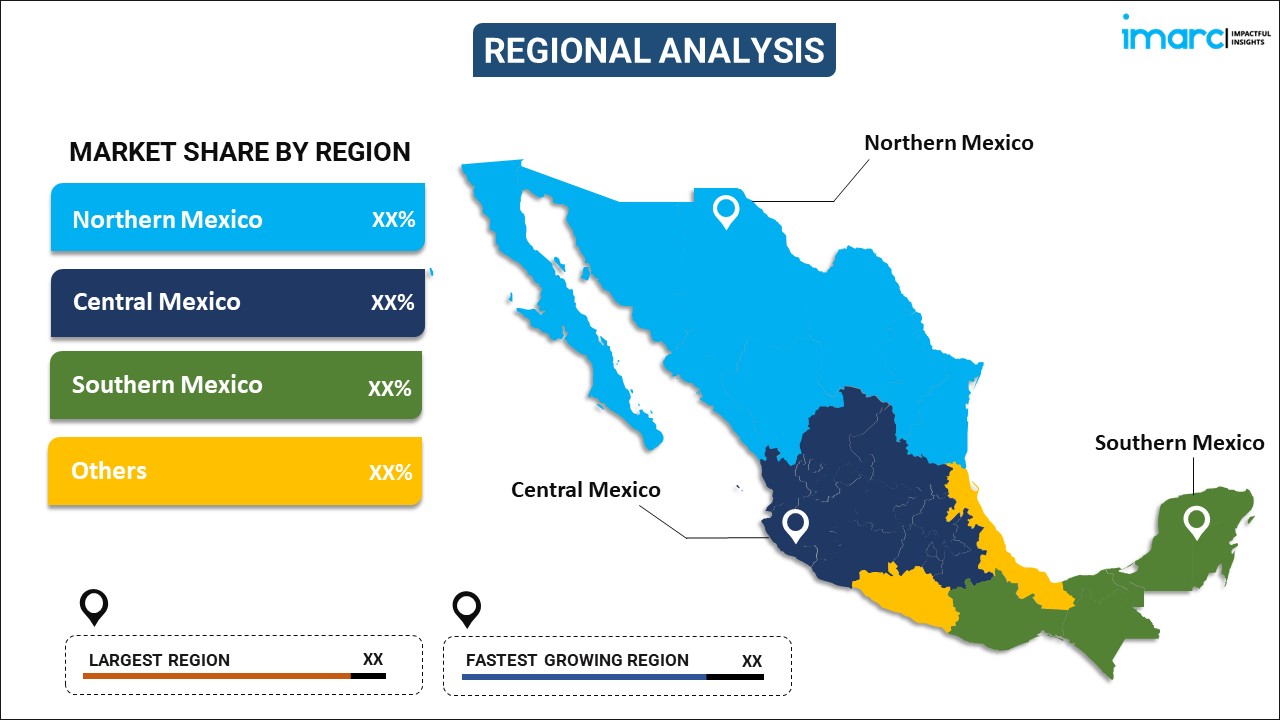
Mexico Real Estate Market Report by Property (Residential, Commercial, Industrial, Land), Business (Sales, Rental), Mode (Online, Offline), and Region 2025-2033
Market Overview:
Mexico real estate market size reached USD 162.3 Billion in 2024. Looking forward, IMARC Group expects the market to reach USD 237.1 Billion by 2033, exhibiting a growth rate (CAGR) of 4.09% during 2025-2033. The increasing technological advancements, which can influence real estate in various ways, from changing work patterns (remote work) to the development of smart buildings and sustainable practices, are primarily driving the regional market.
|
Report Attribute
|
Key Statistics
|
|---|---|
|
Base Year
|
2024
|
|
Forecast Years
|
2025-2033
|
|
Historical Years
|
2019-2024
|
|
Market Size in 2024
|
USD 162.3 Billion |
|
Market Forecast in 2033
|
USD 237.1 Billion |
| Market Growth Rate 2025-2033 | 4.09% |
Real estate refers to tangible property, encompassing land and any structures permanently affixed to it, such as houses or buildings. It represents a significant sector of the economy, involving the buying, selling, and development of property. Real estate includes residential, commercial, and industrial properties, as well as vacant land. The value of real estate is influenced by factors like location, economic conditions, and market demand. Real estate transactions involve complex legal processes, with various professionals, such as real estate agents, brokers, and lawyers, facilitating deals. Investment in real estate can provide both short-term gains through property appreciation and long-term income through rentals. The real estate market's dynamics are influenced by factors like population growth, urbanization trends, and interest rates, making it a crucial aspect of economic activity.
Mexico Real Estate Market Trends:
The real estate market in Mexico is a dynamic and multifaceted sector that is influenced by various factors. Firstly, economic indicators play a pivotal role in shaping the market landscape. Economic growth, employment rates, and consumer confidence are interconnected elements that drive the demand for real estate. Moreover, interest rates act as a significant connector, affecting both the cost of borrowing for homebuyers and the profitability of real estate investments. Furthermore, demographic trends contribute substantially to market dynamics. Population growth, migration patterns, and changes in household structures directly impact the demand for housing and commercial spaces. Additionally, government policies and regulations serve as crucial connectors, influencing zoning laws, tax incentives, and lending practices. Political stability and governance also play a role in shaping investor confidence and, consequently, the real estate market. Technological advancements and urbanization are additional connectors shaping the real estate landscape. Smart city initiatives, digital infrastructure, and the rise of remote work have altered preferences and property values. Environmental considerations, such as sustainability and climate resilience, increasingly influence real estate decisions, connecting the market to regional issues. In essence, the real estate market in Mexico is an intricate web of interconnected drivers, where economic, demographic, political, technological, and environmental factors collectively mold its trajectory.
Mexico Real Estate Market Segmentation:
IMARC Group provides an analysis of the key trends in each segment of the market, along with forecasts at the country level for 2025-2033. Our report has categorized the market based on property, business, and mode.
Property Insights:

- Residential
- Commercial
- Industrial
- Land
The report has provided a detailed breakup and analysis of the market based on the property. This includes residential, commercial, industrial, and land.
Business Insights:
- Sales
- Rental
A detailed breakup and analysis of the market based on the business have also been provided in the report. This includes sales and rental.
Mode Insights:
- Online
- Offline
The report has provided a detailed breakup and analysis of the market based on the mode. This includes online and offline.
Regional Insights:

- Northern Mexico
- Central Mexico
- Southern Mexico
- Others
The report has also provided a comprehensive analysis of all the major regional markets, which include Northern Mexico, Central Mexico, Southern Mexico, and Others.
Competitive Landscape:
The market research report has also provided a comprehensive analysis of the competitive landscape in the market. Competitive analysis such as market structure, key player positioning, top winning strategies, competitive dashboard, and company evaluation quadrant has been covered in the report. Also, detailed profiles of all major companies have been provided.
Mexico Real Estate Market Report Coverage:
| Report Features | Details |
|---|---|
| Base Year of the Analysis | 2024 |
| Historical Period | 2019-2024 |
| Forecast Period | 2025-2033 |
| Units | Billion USD |
| Scope of the Report | Exploration of Historical Trends and Market Outlook, Industry Catalysts and Challenges, Segment-Wise Historical and Future Market Assessment:
|
| Properties Covered | Residential, Commercial, Industrial, Land |
| Business Covered | Sales, Rental |
| Modes Covered | Online, Offline |
| Regions Covered | Northern Mexico, Central Mexico, Southern Mexico, Others |
| Customization Scope | 10% Free Customization |
| Post-Sale Analyst Support | 10-12 Weeks |
| Delivery Format | PDF and Excel through Email (We can also provide the editable version of the report in PPT/Word format on special request) |
Key Questions Answered in This Report:
- How has the Mexico real estate market performed so far and how will it perform in the coming years?
- What has been the impact of COVID-19 on the Mexico real estate market?
- What is the breakup of the Mexico real estate market on the basis of property?
- What is the breakup of the Mexico real estate market on the basis of business?
- What is the breakup of the Mexico real estate market on the basis of mode?
- What are the various stages in the value chain of the Mexico real estate market?
- What are the key driving factors and challenges in the Mexico real estate?
- What is the structure of the Mexico real estate market and who are the key players?
- What is the degree of competition in the Mexico real estate market?
Key Benefits for Stakeholders:
- IMARC’s industry report offers a comprehensive quantitative analysis of various market segments, historical and current market trends, market forecasts, and dynamics of the Mexico real estate market from 2019-2033.
- The research report provides the latest information on the market drivers, challenges, and opportunities in the Mexico real estate market.
- Porter's five forces analysis assist stakeholders in assessing the impact of new entrants, competitive rivalry, supplier power, buyer power, and the threat of substitution. It helps stakeholders to analyze the level of competition within the Mexico real estate industry and its attractiveness.
- Competitive landscape allows stakeholders to understand their competitive environment and provides an insight into the current positions of key players in the market.
Need more help?
- Speak to our experienced analysts for insights on the current market scenarios.
- Include additional segments and countries to customize the report as per your requirement.
- Gain an unparalleled competitive advantage in your domain by understanding how to utilize the report and positively impacting your operations and revenue.
- For further assistance, please connect with our analysts.
 Inquire Before Buying
Inquire Before Buying
 Speak to an Analyst
Speak to an Analyst
 Request Brochure
Request Brochure
 Request Customization
Request Customization




.webp)




.webp)












